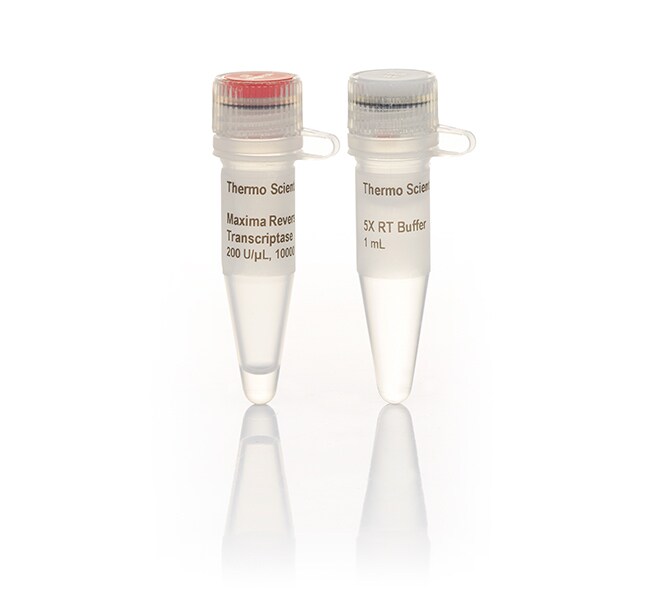Search Thermo Fisher Scientific

Maxima Reverse Transcriptase (200 U/μL)
| Catalog Number | Quantity |
|---|---|
| EP0742 | 10,000 Units |
| EP0741 | 2,000 Units |
| EP0743 | 4 x 10,000 Units |
Thermo Scientific Maxima Reverse Transcriptase (RT) was developed through in vitro evolution of M-MuLV RT. The enzyme possesses an RNA-dependent and DNA-dependent polymerase activity as well as RNase H activity. The engineered enzyme features dramatically improved thermostability and robustness, and increased synthesis rates compared to wild type M-MuLV RT.
Maxima Reverse Transcriptase is capable of reproducible cDNA synthesis from a wide range of input total RNA amounts (from 1 pg to 5 μg) at elevated temperatures (50–65°C), which makes this enzyme an ideal tool for two step RT-qPCR (see supporting data).
Due to its high thermostability, Maxima enzyme maintains full activity during the entire reverse transcription reaction, generates the highest yields of cDNA, and is able to synthesize even very long RNA transcripts up to 20 kb. The reaction temperature can be increased up to 65°C for efficient transcription of RNA regions with a high secondary structure or to improve specificity using gene specific primers. Due to its increased synthesis rate, the reverse transcriptase reaction can be completed in 15 to 30 minutes
Features of Maxima Reverse Transcriptase include:
• High yields of full-length cDNA up to 20 kb
• Active up to 65°C
• Thermostable—90% active after incubation at 50°C for 60 minutes
• High sensitivity allows reproducible cDNA synthesis from a wide range of total RNA quantities (1 pg to 5 μg)
• Efficient formula for complete cDNA synthesis in 15 to 30 minutes
• Incorporates modified nucleotides
Applications
• Two step RT-PCR
• Two step RT-qPCR
• First strand cDNA synthesis
• Construction of full length cDNA libraries
• DNA labeling
• Primer extension
Also available
• Maxima Reverse Transcriptase
• Maxima First Strand cDNA Synthesis Kit for RT-qPCR
• Maxima First Strand cDNA Synthesis Kit for RT-qPCR, with dsDNase
• Maxima Reverse Transcriptase, 1 x 10,000 units (200 U/μL)
• 5X RT Buffer
Store at –20°C.
Figures





Customers who viewed this item also viewed
Documents & Downloads
Certificates
Safety Data Sheets
Frequently asked questions (FAQs)
It is generally beneficial to minimize RNase H activity when aiming to produce long transcripts for cDNA cloning. RNase H degrades RNA from RNA-DNA duplexes, which can result in truncated cDNA during reverse transcription of long mRNA. It is also recommended to use RNase H-minus RTs for template-independent addition of C nucleotides. In contrast, reverse transcriptases with intrinsic RNase H activity are often favored in qPCR applications.
All Thermo Scientific reverse transcriptases possess intrinsic TdT activity although at varying degrees depending upon the reaction conditions. For addition of template-independent C nucleotides (as for SMART and RACE experiments), this specific TdT activity can be induced by Mn2+. We would recommend Maxima H- or RevertAid H- minus RTs for this purpose.
cDNA synthesis at higher temperatures ensures successful transcription of RNA with high levels of secondary structure, reducing issues of primer access to template. Therefore, we do recommend to use RT enzymes with high thermostability, e.g. Maxima and Maxima H Minus Reverse Transcriptases, which provide higher yields of full-length cDNA, better sensitivity, and successful transcription of GC-rich templates.
Trace amounts of reagents used in RNA purification protocols may remain in solution and inhibit first-strand synthesis, e.g., SDS, EDTA, guanidine salts, phosphate, pyrophosphate, polyamines, spermidine. To remove trace contaminants, we recommend re-precipitating the RNA with ethanol and washing the pellet with 75% ethanol, or re-purifying the RNA.
RNA purity and integrity are essential for synthesis and quantification of cDNA. Always assess the integrity of RNA prior to cDNA synthesis. Use freshly prepared RNA. Multiple freeze/thaw cycles of the RNA sample and synthesized cDNA is not recommended. Avoid RNase contamination and discard low quality RNA.